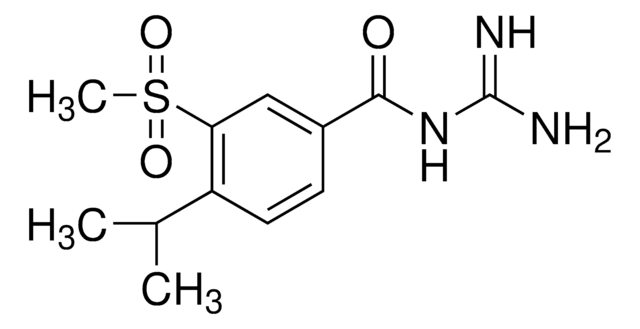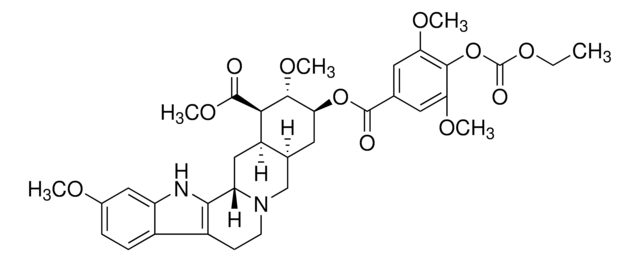A9561
5-(N,N-Hexamethylene)amiloride
Synonim(y):
HMA
About This Item
Polecane produkty
Postać
powder
Poziom jakości
temp. przechowywania
2-8°C
ciąg SMILES
N\C(N)=N\C(=O)c1nc(Cl)c(nc1N)N2CCCCCC2
InChI
1S/C12H18ClN7O/c13-8-10(20-5-3-1-2-4-6-20)18-9(14)7(17-8)11(21)19-12(15)16/h1-6H2,(H2,14,18)(H4,15,16,19,21)
Klucz InChI
RQQJJXVETXFINY-UHFFFAOYSA-N
informacje o genach
human ... SCNN1A(6337) , SCNN1B(6338) , SCNN1D(6339) , SCNN1G(6340) , SLC9A1(6548) , SLC9A5(6553)
mouse ... Scnn1a(20276) , Scnn1b(20277) , Scnn1d(140501) , Scnn1g(20278)
rat ... Scnn1a(25122) , Scnn1b(24767) , Scnn1g(24768) , Slc9a1(24782) , Slc9a3(24784)
Powiązane kategorie
Działania biochem./fizjol.
Cechy i korzyści
Hasło ostrzegawcze
Danger
Zwroty wskazujące rodzaj zagrożenia
Zwroty wskazujące środki ostrożności
Klasyfikacja zagrożeń
Acute Tox. 3 Dermal - Acute Tox. 3 Inhalation - Acute Tox. 3 Oral
Kod klasy składowania
6.1C - Combustible acute toxic Cat.3 / toxic compounds or compounds which causing chronic effects
Klasa zagrożenia wodnego (WGK)
WGK 3
Temperatura zapłonu (°F)
Not applicable
Temperatura zapłonu (°C)
Not applicable
Środki ochrony indywidualnej
Eyeshields, Faceshields, Gloves, type P2 (EN 143) respirator cartridges
Certyfikaty analizy (CoA)
Poszukaj Certyfikaty analizy (CoA), wpisując numer partii/serii produktów. Numery serii i partii można znaleźć na etykiecie produktu po słowach „seria” lub „partia”.
Masz już ten produkt?
Dokumenty związane z niedawno zakupionymi produktami zostały zamieszczone w Bibliotece dokumentów.
Klienci oglądali również te produkty
Nasz zespół naukowców ma doświadczenie we wszystkich obszarach badań, w tym w naukach przyrodniczych, materiałoznawstwie, syntezie chemicznej, chromatografii, analityce i wielu innych dziedzinach.
Skontaktuj się z zespołem ds. pomocy technicznej














